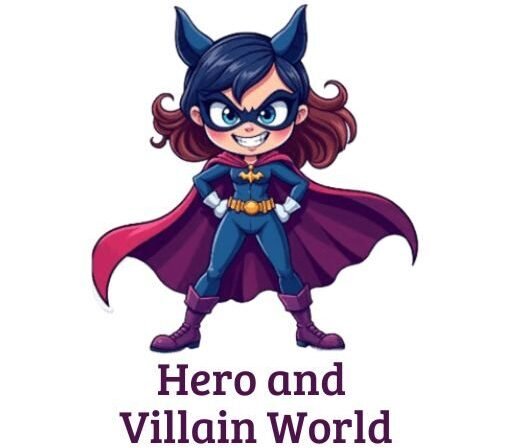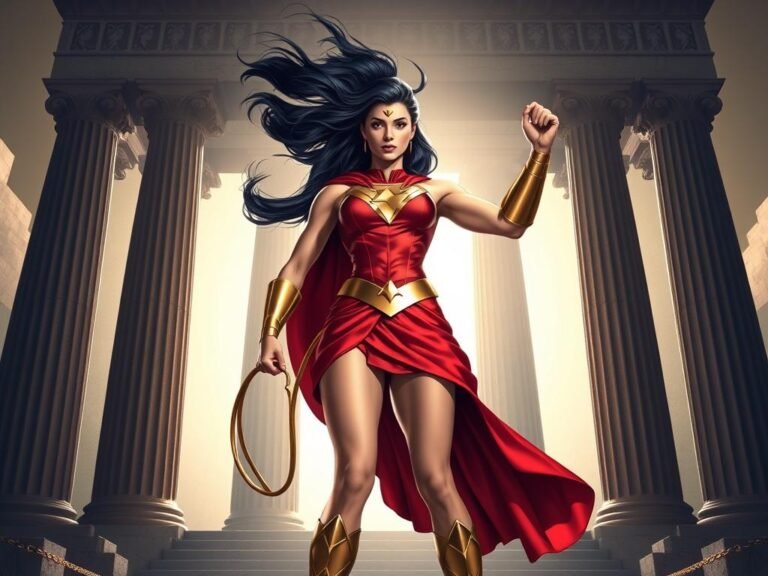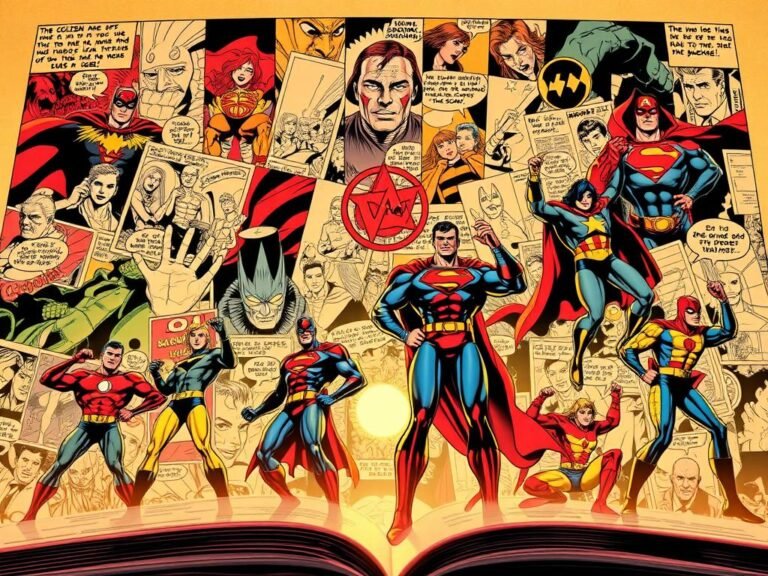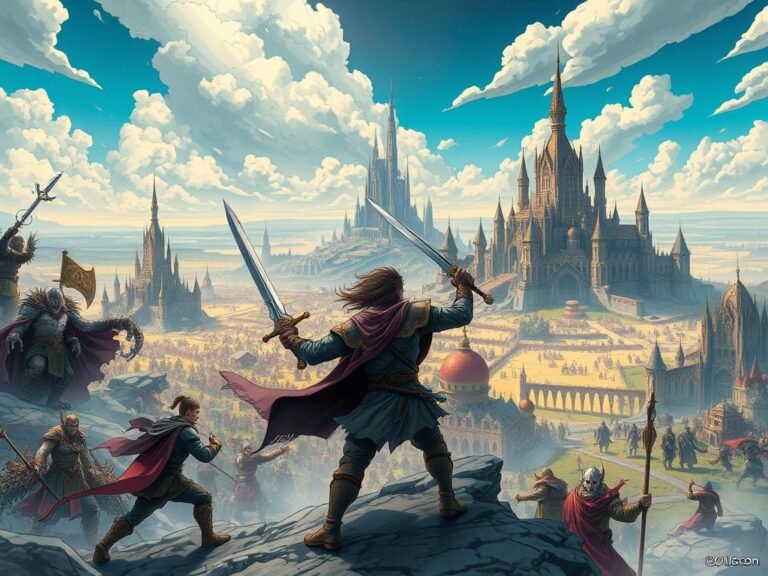The Journey of Science Fiction and Fantasy Comics
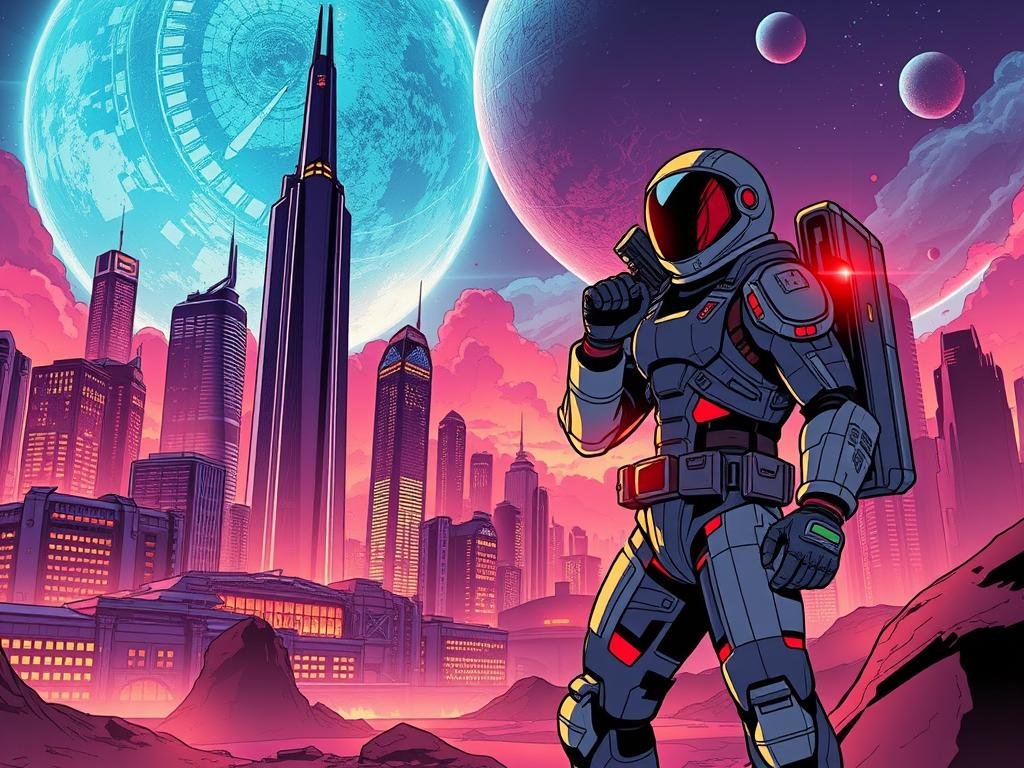
Ever since I was young, science fiction and fantasy comics have been a gateway to worlds beyond imagination.
Titles like The Incal and 2000 AD ignited my curiosity, blending futuristic tales with stunning artwork. These stories didn’t just entertain—they shaped how I see the world.
I remember flipping through underground comic books, marveling at how they pushed boundaries. They weren’t just about heroes in capes; they explored complex themes like space exploration, time travel, and dystopian futures.
Each page felt like stepping into a new story, one that challenged my thinking and fueled my creativity.
This article dives into the evolution of these genres, their cultural impact, and the personal milestones they’ve inspired. From pioneering works to fan-driven movements, we’ll explore how science and imagination collide in the pages of these unforgettable fiction tales.
My Personal Beginnings with Sci-Fi and Fantasy Comics
Growing up in South Africa, I found escape in the pages of sci-fi comics. These stories became my refuge, transporting me to worlds filled with futuristic robots, daring adventures, and unforgettable characters.
Each comic was a gateway to a new genre, blending art and storytelling in ways that left a lasting impression.
One of my earliest influences was Heavy Metal Magazine. Its bold visuals and unconventional narratives pushed the boundaries of what comics could be.
I remember spending hours immersed in its pages, captivated by the intricate work of artists and writers. Titles like The Incal introduced me to complex themes and layered storytelling, sparking my imagination like nothing else.
As a child, I gravitated toward stories with strong characters and unique elements. Whether it was a robot with a heart of gold or a dystopian future filled with intrigue, these tales shaped my understanding of storytelling.
They taught me that comics weren’t just about action—they were about exploring ideas and emotions.
Looking back, I realize how much time I spent with these comics. They weren’t just entertainment; they were a source of inspiration.
Even now, revisiting those childhood favorites fuels my passion for both science and fantasy narratives. As J. Allen Williams once shared in his interview, early influences can shape a creative journey in profound ways.
Early Memories and Influences
My earliest memories of sci-fi comics are tied to moments of discovery. I’d sit cross-legged on the floor, flipping through pages filled with vibrant art and bold ideas.
The genre felt limitless, offering stories that challenged my thinking and expanded my worldview.
Childhood Favorites and Inspirations
Among my favorites were tales of futuristic societies and unconventional heroes. These stories weren’t just about escapism—they were about exploring the human condition through the lens of science and imagination. They remain a cornerstone of my creative evolution.
The Evolution and History of Sci-Fi Comics
From humble beginnings to iconic series, sci-fi comics have shaped storytelling for decades. Their journey reflects not just changes in art and narrative but also the evolving tastes of a dedicated fan base. Let’s dive into this rich history and explore how it all began.

Early pioneers like Buck Rogers and Flash Gordon laid the foundation for the genre. These series introduced readers to futuristic worlds filled with space exploration and daring adventures.
Their influence can still be felt in modern graphic novels, which continue to push boundaries.
British titles like 2000 AD brought a fresh perspective to the genre. With its gritty storytelling and bold visuals, it became a cultural phenomenon. As one critic noted,
“2000 AD redefined what sci-fi comics could achieve, blending social commentary with cutting-edge art.”
The evolution of comic art has been equally transformative. From the simplistic lines of early books to the intricate designs of today, artists have continually raised the bar.
This progression mirrors broader changes in storytelling, making sci-fi comics a dynamic and ever-evolving medium.
Fans have played a crucial role in this journey. Their passion and critical engagement have driven creators to innovate and experiment. This symbiotic relationship between creators and fans has ensured the genre’s enduring popularity.
From Buck Rogers to 2000 AD
Buck Rogers, first published in 1929, is often credited as the first major sci-fi comic. Its success paved the way for other series like Flash Gordon, which further popularized the genre. These early works set the stage for the Golden Age of sci-fi comics.
By the 1970s, British titles like 2000 AD emerged, offering a darker, more complex take on the genre. Its anthology format allowed for diverse storytelling, from dystopian futures to satirical takes on society.
This innovation inspired a new generation of creators and fans alike.
| Title | Year | Impact |
|---|---|---|
| Buck Rogers | 1929 | Pioneered sci-fi comics |
| Flash Gordon | 1934 | Popularized space adventures |
| 2000 AD | 1977 | Redefined the genre with gritty storytelling |
Looking back, it’s clear that these early works were more than just entertainment. They were a testament to the power of imagination and the enduring appeal of sci-fi storytelling. Their legacy continues to inspire creators and fans around the world.
In 1927, World War I veteran Anthony Rogers is working for the American Radioactive Gas Corporation investigating strange phenomena in an abandoned coal mine when suddenly there’s a cave-in. Trapped in the mine and surrounded by radioactive gas, Rogers falls into a state of suspended animation . . . for nearly five hundred years.
Exploring Diverse Subgenres in Sci-Fi and Fantasy Comics
Exploring the vast landscape of comics, I found subgenres that push the boundaries of imagination. From gritty realism to whimsical worlds, these genres offer something for everyone.
Whether it’s a child discovering their first comic or a family sharing adventures, there’s a story for every reader.

Visionary artists have reimagined the comic universe, blending traditional narratives with novel twists. Each subgenre constructs its own rules and aesthetics, expanding the boundaries of comic art.
These experimental blends enrich the overarching narrative, inspiring both creators and fans alike.
Biopunk, Cyberpunk, and Military Sci-Fi
Biopunk explores the ethical dilemmas of genetic engineering, often featuring morally complex characters. Cyberpunk, on the other hand, delves into high-tech, low-life societies, where marginalized individuals fight against oppressive systems.
Military sci-fi, like The Forever War, reflects on the consequences of conflict, blending action with deep philosophical questions.
These subgenres often portray the man of courage in futuristic settings, challenging traditional hero archetypes.
They also cater to a wide audience, from young readers to seasoned fans, making them a cornerstone of the comic world.
Steampunk, Post-Apocalyptic, and Fantasy Blends
Steampunk offers a unique twist, blending 19th-century aesthetics with steam-powered technology. It’s a world where gears and goggles meet fantastical inventions, creating a visually stunning universe.
Post-apocalyptic narratives, like Station Eleven, explore the aftermath of societal collapse, offering both hope and despair.
Fantasy blends, such as science-fantasy, combine elements of both genres, creating stories with technical and magical components. These subgenres cater to diverse audiences, from children to families, ensuring there’s something for everyone.
| Subgenre | Key Themes | Notable Works |
|---|---|---|
| Biopunk | Genetic engineering, ethics | Oryx and Crake |
| Cyberpunk | High-tech, low-life societies | Neuromancer |
| Military Sci-Fi | War, philosophy | The Forever War |
| Steampunk | 19th-century aesthetics, steam tech | Leviathan |
| Post-Apocalyptic | Societal collapse, survival | Station Eleven |
| Fantasy Blends | Magic, technology | The Fifth Season |
These subgenres not only entertain but also challenge our understanding of the world. They reflect the creativity of artists and the evolving tastes of readers. For more on the complexity of these genres, check out this guide on speculative fiction.
The Journey of Science Fiction and Fantasy Comics
From the first time I held a comic in my hands, I knew I was stepping into a universe of endless possibilities. Each page was a gateway to new worlds, filled with adventure and imagination.
Over the years, these stories have become more than just entertainment—they’ve shaped my understanding of storytelling and creativity.
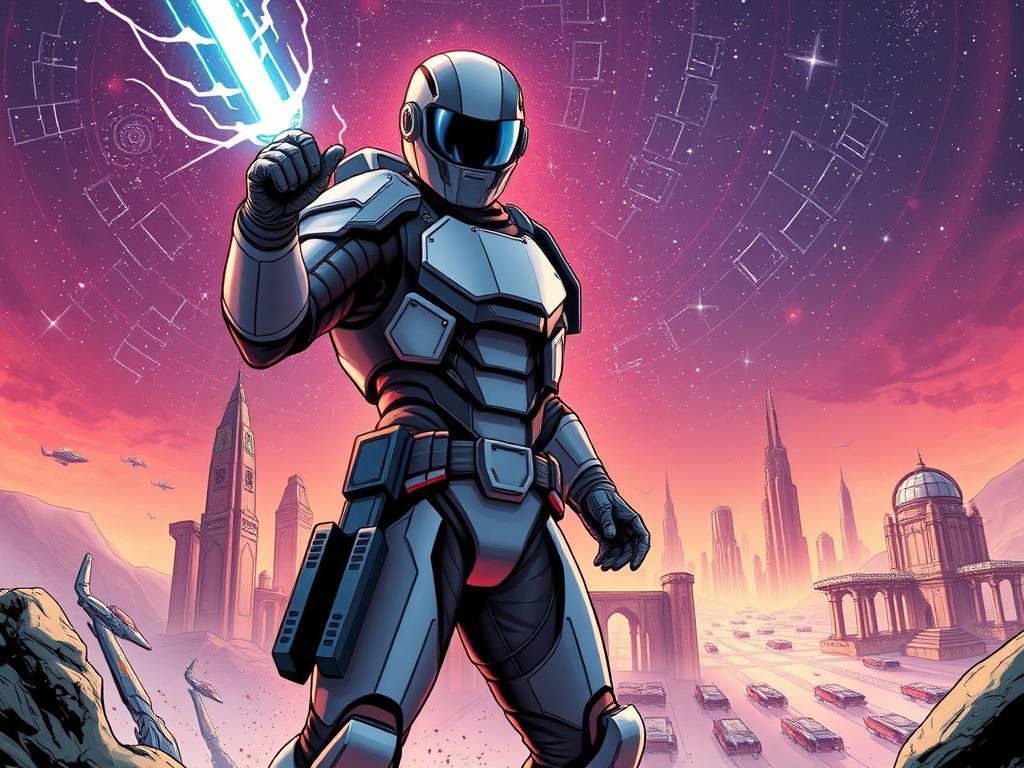
Defining Moments and Iconic Titles
Certain titles stand out as milestones in the evolution of fiction comics. Works like The Incal and 2000 AD redefined what the medium could achieve.
These stories weren’t just about heroes and villains; they explored complex themes like space exploration and dystopian futures.
I remember the first time I read Heavy Metal Magazine. Its bold visuals and unconventional narratives pushed the boundaries of storytelling. Each issue felt like a new adventure, challenging my perceptions and sparking my imagination.
Personal Reflections on Classic and Modern Works
As I grew older, my appreciation for these stories deepened. Classic works from my childhood, like Buck Rogers, laid the foundation for my love of the genre.
Modern titles, such as Saga, continue to push creative boundaries, blending science and fantasy in innovative ways.
Each era of comics has been marked by the work of visionary creators. From the Golden Age to the present day, these artists and writers have shaped the medium, inspiring readers like me to explore new ideas and perspectives.
Looking back, I realize how much these stories have influenced my creative journey. They’ve taught me that comics are more than just pictures on a page—they’re a powerful medium for storytelling and self-expression.
Impact of Sci-Fi Comics on Pop Culture and Media
Over the years, sci-fi comics have left an indelible mark on pop culture, shaping how we experience media. From blockbuster films to groundbreaking TV shows, their influence is undeniable.
Each year, new adaptations and inspired works emerge, proving the genre’s lasting relevance.
Specific years marked turning points where comic narratives began to inform mainstream media. For example, the 1970s saw the rise of 2000 AD, which redefined storytelling with its gritty themes.
This paved the way for modern adaptations that blend sci and fantasy elements seamlessly.
Influence on Television, Film, and Literature
Television and film have borrowed heavily from sci-fi comics, creating immersive worlds that captivate audiences.
Shows like Westworld and films like Blade Runner owe their visual and narrative styles to the genre. Each day, creators find new ways to translate comic art into cinematic brilliance.
Literature has also been shaped by these stories. Authors like Neil Gaiman and Philip K. Dick drew inspiration from comics, blending fantasy with philosophical depth. As one critic noted,
“Sci-fi comics have become a blueprint for modern storytelling, influencing everything from novels to screenplays.”
Pioneers like Fiona Staples have redefined visual storytelling, proving that comics are more than just a medium—they’re a way to explore complex ideas. Her work on Saga has inspired countless creators to push boundaries.
| Medium | Influence | Notable Examples |
|---|---|---|
| Television | Immersive world-building | Westworld, The Expanse |
| Film | Visual and narrative style | Blade Runner, Guardians of the Galaxy |
| Literature | Philosophical depth | American Gods, Do Androids Dream of Electric Sheep? |
The interconnection between comics and pop culture continues to inspire innovative art and media adaptations. As the genre evolves, its impact on our collective imagination remains as strong as ever.
Diving into Comic Cons and Fandom Communities
Walking into a comic con feels like stepping into a vibrant community. The air buzzes with excitement as fans of all ages come together to celebrate their love for comic books.
From cosplay to panel discussions, these events are a testament to the power of shared passion.
Experiencing Comic Con Events and Panels
One of my most memorable experiences was attending a panel featuring Jeff Lemire. His insights into storytelling and character development left a lasting impression.
Panels like these offer fans a chance to connect with creators, deepening their appreciation for the art form.
Here’s a listof panels that stood out:
- Exploring the Evolution of Graphic Novels
- Behind the Scenes with Legendary Artists
- The Role of Diversity in Modern Comics
Each panel tells a tale of creativity and collaboration, inspiring attendees to see comics in new ways. The energy in the room is palpable, as every person shares their enthusiasm for the medium.
The Role of Libraries and Cultural Gatherings
Libraries and cultural centers play a crucial role in fostering fandom. Events like Offaly Libraries Comic Con blend educational resources with the excitement of dedicated cons.
These gatherings create a space where fans can discover new works and revere old classics.
I’ve seen firsthand how these events bring people together. Whether it’s a child discovering their first comic book or a family bonding over shared interests, the sense of community is undeniable. As one attendee put it,
“These events remind us why we fell in love with comics in the first place.”
From cosplay contests to artist meet-and-greets, these gatherings celebrate the diverse world of comics. They’re a testament to the enduring love fans have for the genre.
Celebrating the Art and Innovation of Sci-Fi Comics
The art of sci-fi comics has always been a canvas for boundless creativity. From bold superhero designs to avant-garde manga influences, these works push the boundaries of visual storytelling.
Each creator carves out a unique place in the industry, leaving an indelible mark on the medium.
One of the most striking aspects of sci-fi comics is their ability to explore complex themes. Whether it’s the moral dilemmas of futuristic war or the heroism of unconventional characters, these stories resonate deeply.
They envision a future filled with possibility, blending imagination with technical precision.
Iconic Creators and Inspiring Artwork
Creators like Fiona Staples and Jeff Lemire have redefined what comics can achieve. Staples’ work on Saga blends science and fantasy seamlessly, while Lemire’s narratives delve into the human condition.
Their innovative approaches continue to inspire both fans and fellow artists.
Another standout is Moebius, whose intricate designs and visionary storytelling set a new standard. His work on The Incal remains a cornerstone of the genre, blending surreal art with profound themes. As one critic noted,
“Moebius’ art transcends the page, creating a universe that feels both familiar and otherworldly.”
These creators have not only shaped the future of comics but also influenced other media. Their work has inspired films, TV shows, and literature, proving the enduring power of visual storytelling.
Dramatic Depictions and Forward-Looking Narratives
Sci-fi comics often depict dramatic war scenarios, blending action with deep philosophical questions. Titles like The Forever War explore the consequences of conflict, offering both hope and despair.
These stories challenge traditional hero archetypes, presenting characters with moral complexity.
The genre also embraces diverse influences, from manga aesthetics to steampunk designs. This fusion creates visually stunning worlds that captivate readers. Each comic is a testament to the limitless potential of imagination.
Looking ahead, the future of sci-fi comics is bright. With new creators emerging and technology evolving, the medium continues to push boundaries. As a fan, I’m excited to see where this journey takes us.
Conclusion
Reflecting on my experiences, I’m reminded of the magic I found in these stories as a young girl. Returning home to these beloved tales feels like reconnecting with an old friend.
They’ve shaped my creative life and deepened my appreciation for storytelling.
Sci-fi comics are more than just entertainment. They’re a gateway to new worlds, filled with adventure and imagination.
As a girl, I discovered endless possibilities within their pages. Even now, they inspire me to explore new ideas and perspectives.
I encourage everyone to dive into these timeless works. Share your experiences and celebrate the joy they bring. Let’s honor the legacy of these stories, which continue to spark creativity and wonder in readers of all ages.
Every new comic page holds an unending adventure. Whether you’re a lifelong fan or just starting, there’s always something magical waiting to be discovered.
Here’s to the stories that remind us of the power of imagination and the joy of coming home.
FAQ
What sparked my love for sci-fi and fantasy comics?
My passion began with childhood memories of reading graphic novels like *Saga* by Fiona Staples and Jeff Lemire. These stories opened my mind to new worlds and ideas.
How have sci-fi comics evolved over time?
From classics like *Buck Rogers* to modern series like *2000 AD*, the genre has grown to include diverse themes like space exploration, war, and futuristic societies.
What are some popular subgenres in sci-fi and fantasy comics?
I enjoy exploring biopunk, cyberpunk, and military sci-fi. Steampunk and post-apocalyptic tales also blend fantasy with innovative storytelling.
How have sci-fi comics influenced pop culture?
They’ve shaped television, film, and literature, inspiring iconic works like *Star Wars* and *The Matrix*. Their themes resonate across media.
What’s it like attending comic cons and fandom events?
Comic cons are thrilling! I love meeting creators, attending panels, and connecting with fellow fans who share my love for this universe.
Who are some iconic creators in the sci-fi comic world?
Artists like Fiona Staples and writers like Jeff Lemire have left a lasting impact. Their work continues to inspire readers and creators alike.
Why are libraries important for comic fans?
Libraries offer access to rare titles and host cultural gatherings. They’re a treasure trove for anyone diving into this genre.
What makes sci-fi and fantasy comics timeless?
Their ability to explore universal themes like love, family, and adventure ensures they remain relevant across generations.
